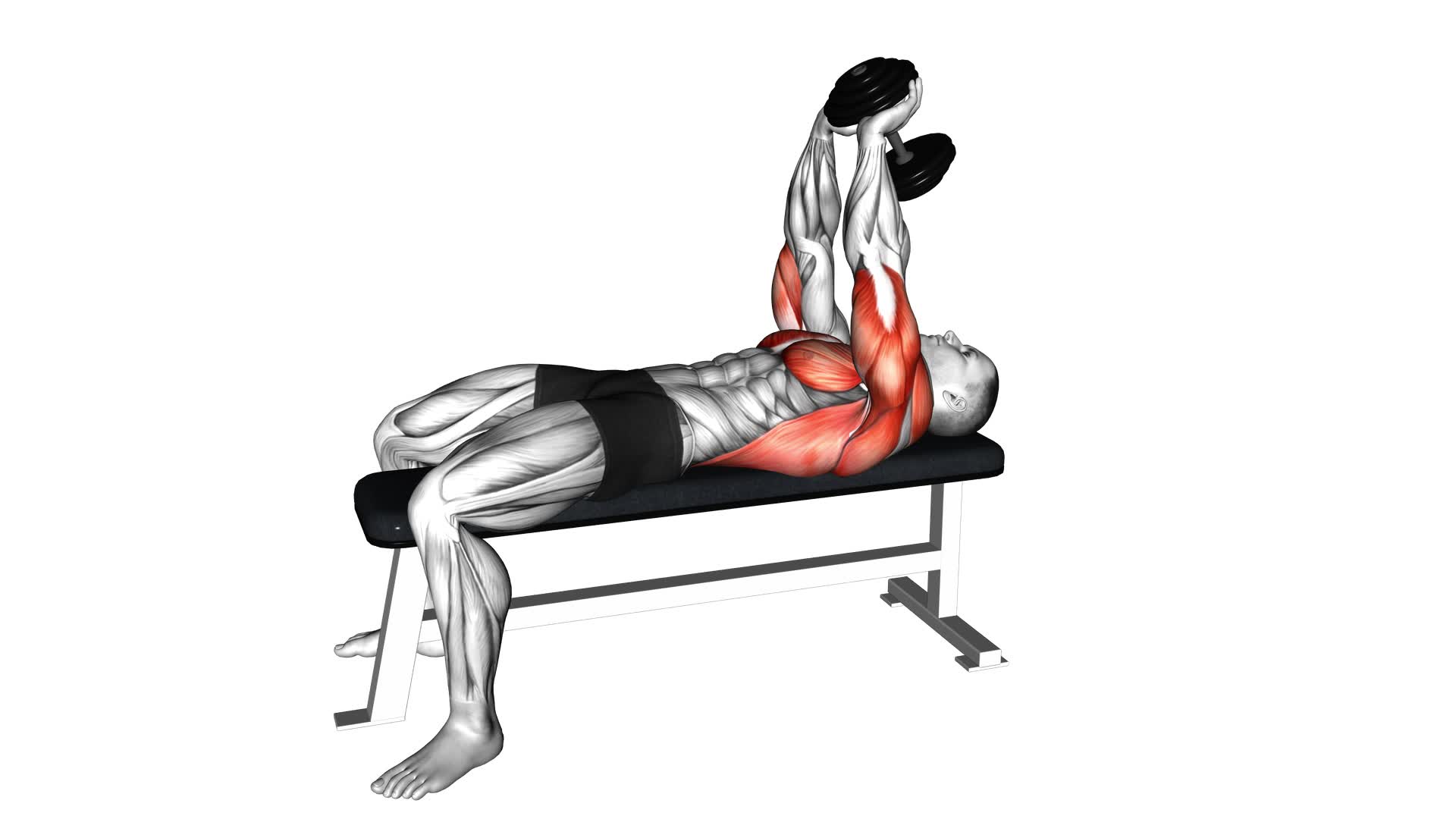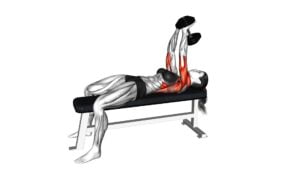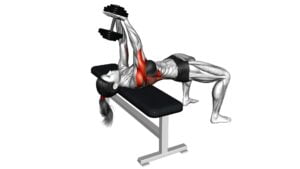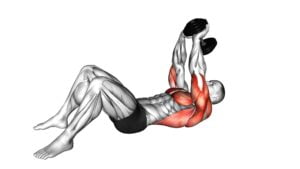Dumbbell Pullover (VERSION 2) – Video Exercise Guide & Tips

Looking to take your workout to the next level?
Watch This Exercise Video
In this video exercise guide, we'll show you how to master the Dumbbell Pullover (Version 2). This variation offers a range of benefits, from targeting your upper body muscles to improving flexibility.
With our step-by-step instructions and helpful tips, you'll learn the proper form and technique to maximize your results and prevent injuries.
So grab your dumbbells and get ready to sculpt and strengthen your body with this effective exercise.
Key Takeaways
- The Dumbbell Pullover (Version 2) targets upper body muscles and engages core muscles for stabilization.
- It can be modified to suit different fitness levels and can be performed with different grip positions to target different muscle groups.
- Proper form and technique include lying flat on a bench with feet planted, holding a dumbbell with palms facing up, and lowering the dumbbell behind the head in a controlled manner.
- To maximize results and prevent injuries, it is important to maintain proper form, start with light weights and gradually increase, and focus on stretching the chest and lats.
Benefits of the Dumbbell Pullover (Version 2)
Discover the benefits you can achieve from incorporating the dumbbell pullover (Version 2) into your workout routine.
The dumbbell pullover (Version 2) is an effective exercise that targets your core strength while also engaging multiple muscle groups. By incorporating the dumbbell pullover (Version 2) into a full body workout routine, you can experience increased muscle activation in your chest, back, shoulders, and triceps.
One of the main benefits of the dumbbell pullover (Version 2) is its ability to strengthen your core. As you perform the exercise, your core muscles are engaged to stabilize your body and maintain proper form. This not only improves your overall core strength but also helps to enhance your balance and stability.
Additionally, the dumbbell pullover (Version 2) is a compound exercise that targets multiple muscle groups simultaneously. This means that you can maximize your workout efficiency by working multiple areas of your body in one exercise. By incorporating the dumbbell pullover (Version 2) into your full body workout routine, you can save time and still achieve a comprehensive workout.
Incorporating the dumbbell pullover (Version 2) into your workout routine can provide you with a variety of benefits, including increased core strength and engagement of multiple muscle groups. Continue reading to learn about the proper form and technique for the dumbbell pullover (Version 2) to ensure you perform the exercise correctly and safely.
Proper Form and Technique for the Dumbbell Pullover (Version 2)
To perform the dumbbell pullover (Version 2) with proper form and technique, engage your core muscles to stabilize your body and maintain balance throughout the exercise. This will help you maximize the benefits of this exercise and reduce the risk of injury.
Start by lying flat on a bench with your feet planted firmly on the ground. Hold a dumbbell with both hands, palms facing up, and extend your arms straight above your chest. Keep your elbows slightly bent throughout the exercise.
Inhale deeply and slowly lower the dumbbell behind your head in a controlled manner. Keep your arms straight as you do this. You should feel a stretch in your chest and lats.
Exhale as you bring the dumbbell back to the starting position, focusing on using your chest and lats to pull the weight up. Keep your core engaged and avoid arching your back.
To add variation to the dumbbell pullover, you can try using a stability ball instead of a bench. This will engage your core muscles even more and challenge your balance.
Remember to start with a weight that allows you to maintain proper form and gradually increase the weight as you become more comfortable with the exercise. By performing the dumbbell pullover correctly and incorporating variations, you can maximize the benefits and see improvements in your upper body strength and stability.
Variations and Progressions for the Dumbbell Pullover (Version 2)
Try incorporating different grip variations into your dumbbell pullovers to target different muscles and add variety to your workout routine. Here are some progressions and modifications you can try to take your dumbbell pullovers to the next level:
- Alternating Grip: Instead of using the same grip throughout the exercise, alternate between an overhand grip and an underhand grip. This variation will engage different muscles in your back and chest, providing a more balanced workout.
- Wide Grip: Place your hands wider than shoulder-width apart on the dumbbell. This variation will emphasize your chest muscles and increase the range of motion.
- Narrow Grip: Bring your hands closer together, almost touching, on the dumbbell. This variation will target your triceps and the inner portion of your chest.
- Weight Progression: As you become comfortable with the exercise, gradually increase the weight of the dumbbell. This will challenge your muscles and help you continue making progress.
- Stability Ball: To add an extra challenge and engage your core muscles, perform the dumbbell pullover while lying on a stability ball. This modification will require more balance and stability throughout the movement.
Incorporating these variations and progressions into your dumbbell pullovers will keep your workouts interesting and help you continue making gains in strength and muscle development.
Common Mistakes to Avoid During the Dumbbell Pullover (Version 2)
To avoid common mistakes during the dumbbell pullover (Version 2), ensure that you maintain proper form and control throughout the exercise.
One common mistake to watch out for is using momentum to swing the weights instead of using controlled movements. This can reduce muscle activation and decrease the effectiveness of the exercise. Remember to keep your core engaged and your back flat on the bench throughout the movement.
Another mistake to avoid is using weights that are too heavy. Using excessive weight can lead to improper form and increase the risk of injury. Start with a weight that challenges you but still allows you to perform the exercise with proper technique.
It's also important to avoid lifting the dumbbell too far back behind your head. This can put unnecessary strain on your shoulders and potentially cause injury. Instead, focus on lowering the weight until your upper arms are parallel to the floor.
Lastly, make sure to avoid holding your breath during the exercise. Proper breathing helps to stabilize your core and maintain control. Inhale as you lower the weight and exhale as you lift it back up.
Tips for Maximizing Results and Preventing Injuries With the Dumbbell Pullover (Version 2)
To maximize your results and prevent injuries with the Dumbbell Pullover (Version 2), focus on using proper form and gradually increasing the weight. Here are some tips to help you maximize gains and prevent injuries:
- Maintain proper form: Keep your back flat against the bench and your core engaged throughout the exercise. This will ensure that you target the intended muscles and reduce the risk of straining your back.
- Start with light weights: Begin with a weight that allows you to perform the exercise with proper form and control. As you become more comfortable, gradually increase the weight to continue challenging your muscles.
- Control the movement: Slowly lower the dumbbell behind your head, feeling a stretch in your chest and lats. Avoid using momentum or jerking motions, as this can lead to muscle strains or joint injuries.
By following these tips, you can maximize the gains from your Dumbbell Pullover (Version 2) workouts while minimizing the risk of injury. Remember to always listen to your body and consult with a fitness professional if you have any concerns or questions.
Keep pushing yourself, but always prioritize safety and proper technique.
Frequently Asked Questions
Can the Dumbbell Pullover (Version 2) Help Me Lose Weight?
Yes, the dumbbell pullover (version 2) can help you lose weight. By incorporating this exercise into your fitness routine, you can benefit from its ability to target multiple muscle groups, including your chest, back, and shoulders.
This exercise also engages your core, promoting overall strength and stability. To maximize results, focus on proper technique, maintaining control throughout the movement, and gradually increasing the weight.
Remember to consult a fitness professional for personalized guidance.
Is the Dumbbell Pullover (Version 2) Suitable for Beginners?
Yes, the dumbbell pullover (version 2) is suitable for beginners.
It's a great exercise to incorporate into your workout routine as a beginner.
The dumbbell pullover technique for beginners is quite simple and easy to learn.
By doing this exercise, you can strengthen your upper body muscles, improve your posture, and increase your overall fitness level.
It's a safe and effective way to start building strength and endurance.
Can the Dumbbell Pullover (Version 2) Be Done With Other Equipment Besides Dumbbells?
Yes, the dumbbell pullover (version 2) can be done with other equipment besides dumbbells. There are alternative options such as using a barbell, resistance bands, or even a stability ball.
However, it's important to note that the dumbbell pullover offers unique benefits such as targeting the chest, back, and core muscles. It also helps improve shoulder flexibility and stability.
How Often Should I Incorporate the Dumbbell Pullover (Version 2) Into My Workout Routine?
To properly incorporate the dumbbell pullover (version 2) into your workout routine, it's important to follow the correct technique and avoid common mistakes.
Start by performing the exercise two to three times a week, allowing for rest days in between. Remember to maintain proper form, keeping your core engaged and your back flat on the bench.
Avoid using excessive weight and jerky movements, as this can lead to injury. Consistency and proper form are key for optimal results.
Can the Dumbbell Pullover (Version 2) Help Improve My Posture?
Yes, the dumbbell pullover (version 2) can help improve your posture. By targeting the muscles in your back, shoulders, and core, this exercise can strengthen the supporting muscles that play a key role in maintaining proper posture.
To maximize the benefits, it's important to perform the dumbbell pullover with correct form. This involves keeping your core engaged, maintaining a stable position, and focusing on a controlled and smooth movement.
Conclusion
In conclusion, the dumbbell pullover (Version 2) is an effective exercise for targeting the chest, back, and core muscles. By following proper form and technique, you can maximize your results and prevent injuries.
Remember to start with lighter weights and gradually increase the intensity as you build strength. Incorporating variations and progressions can also help challenge your muscles and keep your workouts interesting.
Avoid common mistakes and listen to your body to ensure safe and effective workouts.

Author
Years ago, the spark of my life’s passion ignited in my mind the moment I stepped into the local gym for the first time. The inaugural bead of perspiration, the initial endeavor, the very first surge of endorphins, and a sense of pride that washed over me post-workout marked the beginning of my deep-seated interest in strength sports, fitness, and sports nutrition. This very curiosity blossomed rapidly into a profound fascination, propelling me to earn a Master’s degree in Physical Education from the Academy of Physical Education in Krakow, followed by a Sports Manager diploma from the Jagiellonian University. My journey of growth led me to gain more specialized qualifications, such as being a certified personal trainer with a focus on sports dietetics, a lifeguard, and an instructor for wellness and corrective gymnastics. Theoretical knowledge paired seamlessly with practical experience, reinforcing my belief that the transformation of individuals under my guidance was also a reflection of my personal growth. This belief holds true even today. Each day, I strive to push the boundaries and explore new realms. These realms gently elevate me to greater heights. The unique combination of passion for my field and the continuous quest for growth fuels my drive to break new ground.







